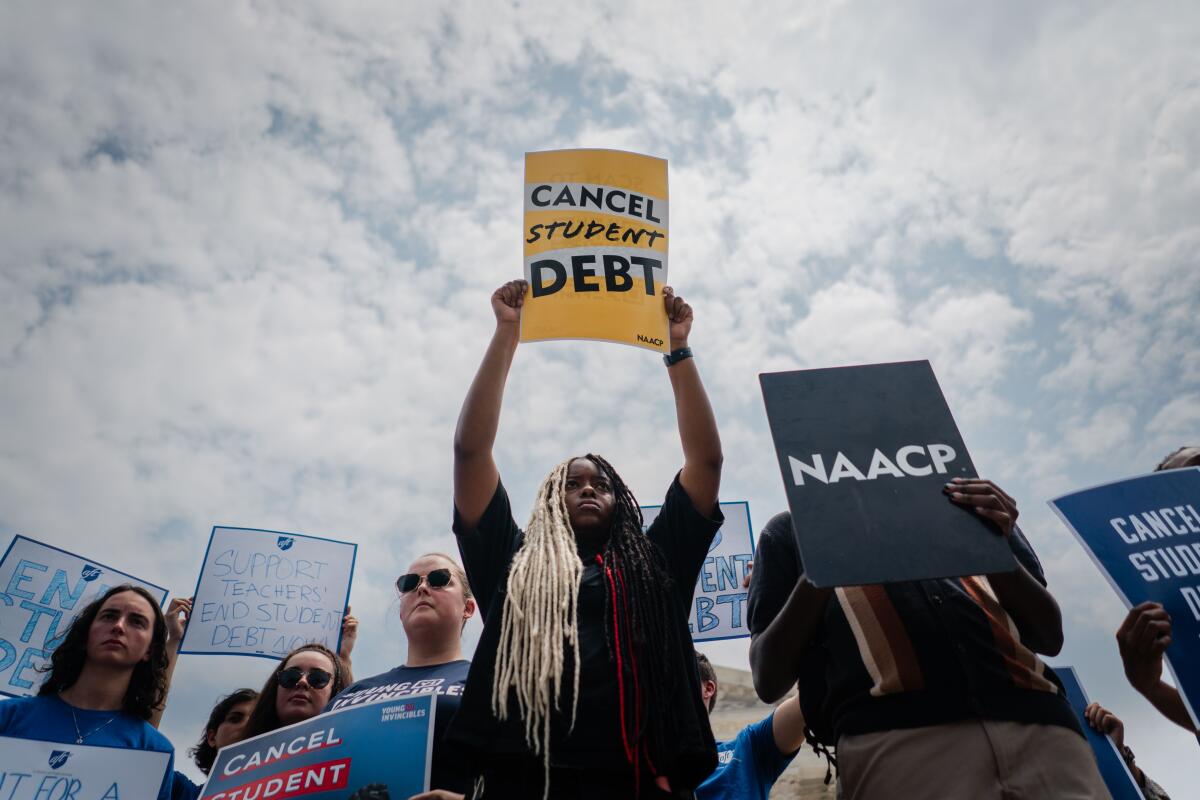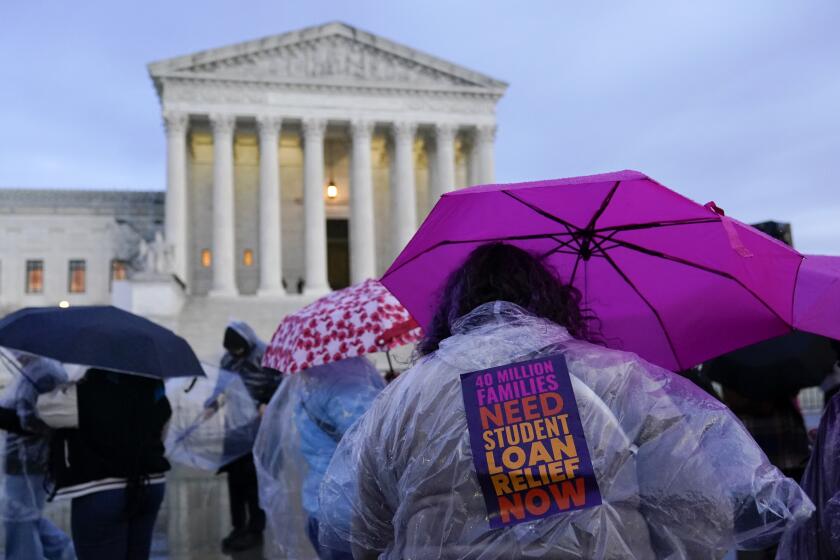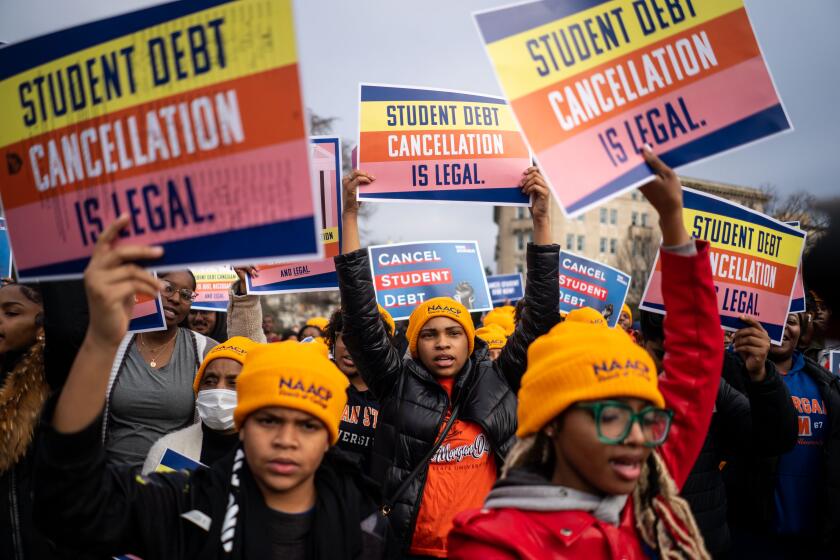Crushed student loan borrowers are skipping meals, moving in with parents, panicking over money

- Share via
Mimi Hoang rejoiced when President Biden announced plans last year to cancel thousands of dollars in student debt. The 20-year-old had taken out $30,000 in federal loans to pay for her first year at Southern Oregon University.
“It is a real burden for me to know that I carry that much from one year of school,” she said.
As she faced the prospect of tripling her loan debt by staying at Southern Oregon, Hoang decided to move back to her family’s home in Hayward last academic year and enroll at a community college. Biden’s plan would have slashed Hoang’s debt to $10,000.
But her hope of relief — and the hopes of millions of borrowers across the country who owe about $1.6 trillion in federal student loans — were crushed Friday when the Supreme Court blocked Biden’s plan. In a 6-3 ruling in Biden vs. Nebraska, the conservative majority ruled only Congress could authorize such a large-scale cancellation of government-provided loans, and it had not done so.
The Supreme Court has ruled that President Biden does not have the authority to forgive millions of student loans.
Hours after the Supreme Court decision, Biden announced he would move again to enact debt relief under the 1965 Higher Education Act, a different law from the initial one he used. This process probably will take more time, but Biden believes it is legally sound and offers the strongest path to borrower relief.
The administration also said it would institute a temporary 12-month “on-ramp repayment program” that would temporarily protect borrowers from default or damage to their credit if they miss payments.
Still, for borrowers the Supreme Court ruling comes at a time of financial precarity as they struggle to make ends meet — especially in high-cost regions such as Los Angeles and the Bay Area — with exorbitant rents and rising food and gas prices. The ruling adds intensifying pressure on their personal budget reckoning, with student loan repayments set to restart in October after a three-year pandemic reprieve.
Some borrowers, including those who are the first in their families to attend college, talked of skipping meals to save money, panicking over how to squeeze hundreds of dollars more from tight budgets and returning home to live with parents.
“It’s something that still follows me throughout my day-to-day life,” Hoang said. “It fills me with a lot of anxiety and stress.”
Others expressed disappointment and said they would do their best to manage.
Jemeryas Jordan, 24, was aware of the political forces surrounding the president’s plan. But for a year he had allowed himself to dream. If the court had upheld student loan forgiveness, the TikTok creator could pour money into his content with new camera equipment, microphones and a laptop.
Jordan is in his third term at Los Angeles City College, where he studies filmmaking. So far he’s accrued over $5,000 in federal loans, most of which has gone toward paying for off-campus housing. He thinks the resumption of payments will be a jolt for many.
“There’s people who are still trying to recuperate and recover from the pandemic,” he said. Though disappointed, he is resolved to a future that includes loan payments. “It’s kind of like, ‘OK, this [debt] is there, and I’ll have to get to it when I get to it,’” he said.
Jordan advised students to “understand the severity of taking it out. This is other people’s money and they will come for it.”
The Biden administration argued it had authority to cancel the loans as part of its emergency response to the COVID-19 pandemic and under a 2003 law called the HEROES Act, passed at the time of the Iraq war. The Supreme Court ruled the act does not allow the administration “to rewrite that statute to the extent of canceling $430 billion of student loan principal.”
The Supreme Court has ruled against the Biden administration’s blanket college loan forgiveness plan, denying debtors the instant relief the program offered. But they still have better options for managing their debt than they did before the court took up the case.
Under the blocked plan, the federal government would have forgiven up to $10,000 in loans for borrowers making $125,000 a year or less and $20,000 for borrowers who received Pell Grants — money awarded to students from families with exceptional financial need. The relief would have applied to loans borrowed on or before June 30, 2022, including those taken out by parents to finance their children’s education.
The plan would have hugely benefited California borrowers, who hold the largest share of federal debt owed by 43 million current and former college and trade school students nationwide. About 4 million Californians hold an average student loan debt of $37,783, according to the Federal Reserve Bank of New York.
For the last several years, however, student loan debt nationally has been declining. Among undergraduates at four-year institutions, the average annual federal loan peaked at $6,450 in 2010-11 and dropped to $3,780 in 2021-22, according to the nonprofit College Board. At the University of California, the proportion of undergraduates with federal loans declined from 44.7% in 2010-11 to 23.6% in 2021-22.
The bigger burden is graduate student debt, with average annual loans nearly doubling from an average $11,930 per person in 2001-02 to $21,230 in 2010-11 before slowly declining to $17,680 in 2021-22.
Fewer students are taking out loans in part because grant aid is increasing — from an average of $8,570 per student in 2010-11 to $10,590 in 2021-22 — and more families are nervous about amassing debt.
Jacqueline Villatoro, a counselor at West Adams Preparatory Academy, said more students these days in her largely low-income school in Pico-Union don’t want to pay for college with loans, fearful about the financial burden after seeing relatives who went to college struggle with debt, she said.
“Any mention of loans, even federal loans, and their parents are very scared to take that leap,” Villatoro said.
For those with debt, default is a big worry — especially as repayments are scheduled to restart.
As the amount of student loan debt continues to grow, more and more borrowers are seeking alternative ways to get relief. But many companies promising to help are just trying to exploit borrowers’ desperation.
“There’s going to be a high risk of default for a bunch of borrowers being forced back into a broken student loan system,” said Samantha Seng, legislative director and policy advisor at NextGen Policy, a California-based nonprofit.
Defaulting on loans carries serious consequences: Borrowers who struggle to pay could take a hit to their credit, hampering their ability to take out a loan for a home, car and other large purchases. It could also lead to wage garnishment.
Black and Latino borrowers are disproportionately vulnerable to default, according to a 2019 analysis from the Center for American Progress, a policy institute. Thirty-two percent of Black borrowers and 20% of Latino borrowers who entered college in 2011 and were required to start repayment by 2017 defaulted on their student loans, compared with 13% of white borrowers.
“You’re asking people to mortgage their futures in order to have a future,” said Jessica Thompson, vice president of the Institute for College Access and Success, which advocates for college affordability.
Hoang feels the financial pressure. A first-generation Vietnamese American, Hoang said she had to navigate the student loan process on her own. Her mom, a nail salon owner, and her dad, who owns a construction and landscaping company, did not have the financial literacy to help her apply for loans, she said.
And as a teenager, Hoang didn’t fully understand how borrowing tens of thousands of dollars would affect her future.
“I was very naive back then. I was like, ‘It’s a loan, everybody has student debt. It’ll be OK,’” she said. “I don’t think it’s fair at all to have that big of a responsibility ... and have that much debt as an 18-year-old.”
Biden’s plan to forgive up to $20,000 in student loans is held up in the courts. But the administration has already canceled billions in debt.
Hoang plans to transfer to UC Berkeley in the fall. Financing her education will remain a challenge.
After grants, she expects to pay $8,000 a year to attend Berkeley. She plans to pay tuition using money she saves from her internship in a state senator’s office, and some help from her parents. And she plans on living at home and commuting more than an hour to campus to save money.
Hoang said the decision to block student loan forgiveness sends a clear signal to students like her.
“The message that they’re throwing out is: We want to keep it this way. We want to keep it so that only people that come from privileged backgrounds, or that have the money to do so, can go to college,” she said. “They want to keep out minorities and marginalized communities, and keep them uneducated.”
Under the debt relief plan, 24-year-old Kevin Rivera would have had $20,000 of his loans forgiven, leaving a $500 balance. As a student at Sacramento State, he worked as a resident advisor, student instructor and at a nonprofit dedicated to bolstering the enrollment of men of color in higher education.
But he still had to take out loans so he could use his wages to help support his family in Long Beach. He pays his own living expenses, and sends money to his mom and two siblings to help with their rent and utilities. Paying to maintain both homes costs him around $1,800 a month.
“If I don’t help out my family financially, they wouldn’t have a roof over their head,” he said. “I can’t have that.”
Rivera, who graduated in May, landed a full-time position at the nonprofit. The $22-an-hour in pay is more than he earned in college, but his rent will also increase since he can no longer live in student housing. Finding an extra couple of hundred dollars each month to pay back his loans, he said, has induced more stress — and has him second-guessing his future.
Rivera had crafted a budget based on his new salary. He’ll now have to go back and take a closer look at his expenses, and look to cut back on money he allotted for meals, restaurants and outings with friends — or redirect money he would have put in savings toward loan payments.
He wants to work as an immigration attorney. But the prospect of piling on more debt to attend law school is daunting.
“I’m going into education to try to further my career, get a better-paying salary,” Rivera said. “But when you graduate with that amount of debt, it’s kind of like: How much of that salary is going to be going back to paying all that debt?”
Older borrowers, including parents, are also struggling under the weight of their debt — and the resumption of payments. Borrowers who took out parent PLUS loans were eligible for debt relief under Biden’s plan.
More than a decade ago, Varela Sanchez took out $9,000 in parent PLUS loans for her daughter, who attended Cal State East Bay for a year before deciding to leave. Before the pause on repayments during the pandemic, Sanchez made loan payments of about $75 a month while working as a TSA officer at LAX. The 51-year-old’s entire debt would have been wiped out under the forgiveness plan.
Looking back, Sanchez said she would have encouraged her daughter to attend community college instead of starting at a costlier four-year university.
Sanchez said she has struggled to find full-time work over the last few years and is spending her days caring for her 4-month-old grandson. She doesn’t have a permanent home, staying for weeks at a time with her daughter, who works as a security officer, or a friend.
Her goal is to try to scrape together money for at least one repayment when they start again in October. She recently started an Etsy storefront selling baby onesies, and is enrolled in a training program to learn digital marketing.
“Everything just exploded in price,” she said. “Sometimes I would go without a meal or two.”
Sadia Khan, 28, had little hope the Supreme Court would rule in favor of borrowers. She graduated in 2021 from UC Berkeley with $6,000 in federal loans. Plus she owes the university $10,000 in back rent for family housing. Adding to her pressure is that she personally borrowed thousands more from family.
She is earning $65,000 a year as a policy coordinator at a nonprofit. Yet she knew she had to cut back expenses. Her gas and electric bill, which previously ran up to $100 per month, has dropped to $20. She slashed her grocery budget in half to about $100 a week, swapping out ready-to-heat meals for lentils, grains and rice. She often eats one meal a day and doesn’t turn on the lights in her home until it gets dark.
Even so, she hasn’t been able to catch a break: Mold forced her to move out of her Bay Area apartment, setting her back around $8,000 in rent, movers and deposits.
“I’ve been so stressed and lethargic all the time. It’s like I’m going through the motions,” she said. “It almost feels like I’m a zombie, just getting through day to day.”
On Friday morning, Khan, who was at a work conference, had tried to ignore any news about the ruling. A day earlier, she received a call from Berkeley about a missing payment.
Now she is bracing for her return home, where she’ll sit down and figure out how much more she can cut. But she is running thin on options. A trip to the fair with her son this year now looks out of reach.
“There’s only so many costs you can cut,” she said. “There’s only so many sacrifices you can make until it mentally breaks your spirit.”
She had urged friends and former classmates to fill out an application for loan forgiveness when Biden announced the plan last year. Now she feels guilty for giving them false hope.
“I was getting so many people hyped for it and am now realizing, holy smokes, we’re screwed,” she said.
More to Read
Sign up for Essential California
The most important California stories and recommendations in your inbox every morning.
You may occasionally receive promotional content from the Los Angeles Times.


















